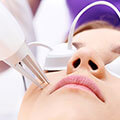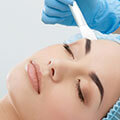
Best Treatment for Osteoporosis in Hyderabad
Osteoporosis is a metabolic bone disease that leads to low bone density, it develops when the body breaks down more bone tissue than it could replace.
Bones become very weak and brittle that even a mild stress such as coughing can cause a fracture. The fractures mostly occur in the hip, wrist or spine. Osteoporosis can affect both men and women, but it is most commonly found in women especially after menopause, this is because of drastic decrease in ovaries production of the hormones estrogen and progesterone. Estrogen is the hormone that mainly protects against osteoporosis.
Causes and risk factors:
Osteoporosis means porous bone, a healthy bone looks like a honeycomb. At young age your body will make new bone very faster than it breaks down old bone due to which your body mass increases. When osteoporosis disease occurs, these honeycomb holes on the bone becomes larger than the healthier bone, because of this, the bones will lose the density and contain abnormal tissue structure. When these bones become less dense they will be weak and are more likely to break.
Risk factors:
Age: Osteoporosis affects all age groups, but it is more for older people than younger people. It is not that every older person gets this disease, but it is comes more common with age.
Reduced sex hormones: when estrogen hormone level drops after menopause, bone loss increases. The same happens, when your ovaries are removed because your ovaries produce most of the body’s estrogen.
Ethnicity: This disease is more common in white people and Asians.
Bone structure: both men and women who are thin or small body structure have more tendencies to get osteoporosis because of less bone mass.
Genetic factors: Having a close family member with a hip fracture makes osteoporosis more likely for you. If you have any family member who had a height loss or a spine that curved forward, they might have had broken bones in their spine.
Fracture history: if any member of your family had a low level injury or fracture, especially after the age of 50 years may have osteoporosis.
Smoking, inactive lifestyle, poor diet, heavy alcohol consumption are linked to bone loss and a risk of fractures.
Thyroid problems: this can occur if you have a overactive thyroid and also due to the medication taken to control the underactive thyroid.
Long term use of steroids and other medication: The risk is higher among people who have certain medical problems like celiac disease, inflammatory bowel disease, kidney or liver disease, cancer, lupus, multiple myeloma, rheumatoid arthritis.
Risk factors which can be changed and controlled:
- Eating disorders, such as anorexia or bulimia nervosa.
- Smoking
- Intake of excessive alcohol
- Deficiency of calcium, magnesium, and vitamin D, due to dietary factors, malabsorption problems, or the use of some medications.
- Inactivity
So being active and exercising will help to revise osteoporosis. It will give stress to the bones and promotes new bone growth.
Signs and symptoms:
Loss of bone mass doesn’t happen all of sudden. It is not noticeable by the people until they have pain, loss of function or fracture. The pain of osteoporosis is similar to arthritis so people get confused with the symptoms.
- Back pain often caused because of fracture or collapsed vertebra.
- Gradual loss of height
- Curved spinal code.
- Stiff and painful joints
- Bone breaks much easy than expected, after a minor injury.
Tests and diagnosis:
A doctor will consider the patient's family medical history and their risk aspects. If doctor has any doubt of osteoporosis, they will request an examination, to measure bone mineral density (BMD). It’s a machine that uses low levels of X-rays to find the proportion of mineral in your bones. It is a painless test where the scanner passes over your body; usually few bones are checked mostly in the hip and spine.
Other tests:
If the patient is losing the height or who has back pain that is not related to another condition then a lateral vertebral assessment (LVA) will be suggested.
An ultrasound scan of the heel bone is an alternative way to evaluate for osteoporosis. It can be carried out in the primary care setting. False positives are very frequent.
Treatment for osteoporosis:
Treatment aims to slow or prevent the development of osteoporosis and maintain healthy bone mineral density and bone mass to prevent fractures in next 10 years. The medications are given to reduce pain and increase the person's ability to continue with their daily life.
This is done through few lifestyle changes, taking supplements and some drugs. These drugs reduce the new bone damage and promote healing.
Drugs given for bone boosting:
Drugs given to prevent and treat osteoporosis include:
Bisphosphonates: this drug is given to block the cells that destroy bone and also helps in building bone density. There will be few side effects like nausea, abdominal pain, and heartburn like symptoms. Intravenous form of medicines does not cause stomach pain but can cause fever, headache, muscle aches for up to three days. These injections are taken 3 to 4 times a year.
SERMS - Estrogen agonists or antagonists, also known as selective estrogen-receptor modulators, SERMS), for example, raloxifene: These can reduce the risk of spine fractures in women after menopause.
Calcitonin: This helps avert spinal fracture in postmenopausal women, and it can help manage pain if a fracture occurs.
Parathyroid hormone, for example, teriparatide- this is approved for people with a high risk of fracture, as it stimulates new bone formation. It’s is taken daily by injection for two years, after that another osteoporosis drug is taken to maintain the new bone growth.
Prolia is an antibody produced in the lab that slows the breakdown of the bone. This injection is given twice a year, it is given to the postmenopausal women who are unable to tolerate other osteoporosis drugs and are at high risk of fractures and also who did not have any benefit with other drugs.
RANK ligand (RANKL) inhibitors, such as denosumab: This is an immune therapy and a new type of osteoporosis treatment which prevents key proteins in the body from breaking down bone cells. This will help in increasing bone density.
Prevention:
Certain alterations to lifestyle can help to reduce the risk of osteoporosis such as eating Calcium rich foods like fish, milk, leafy vegetables provide magnesium, which helps to maintain good bone quality. Consume foods which have vitamin C and D.
Some foods are harmful to the body and can reduce the calcium in the body. So, reduce salty foods, caffeine may decrease your body’s absorption of calcium. This is only for people who consume coffee too many times a day.
Avoid alcohol as it leads to bone loss. Instead try to drink vitamin D fortified milk, orange juice, cereals yogurt and cheese to get calcium.
Older people need more calcium so you can take supplements for healthy bones. Consult your doctor for this.
Bone bearing exercises will help you to maintain healthy bones. Exercises such as walking, jogging, swimming, other activities will help.
Maintain a healthy weight by balanced diet.
Side effects associated with osteoporosis medications:
Like any medication, osteoporosis medications can have potential side effects. These can vary depending on the specific medication prescribed. Common side effects may include gastrointestinal issues, muscle or joint pain, and, in rare cases, atypical fractures. It is important to discuss potential risks and benefits with your healthcare provider.
Can osteoporosis be cured?
Osteoporosis is a chronic condition that cannot be cured completely. However, with appropriate treatment and lifestyle modifications, it is possible to slow down bone loss, reduce the risk of fractures, and manage symptoms effectively.
Foods that can negatively impact bone density:
- High-Sodium Foods: Consuming excessive sodium can lead to increased calcium excretion through urine, which can weaken bones over time. Limiting the intake of processed and fast foods, canned soups, and salty snacks is recommended.
- Excessive Caffeine:High caffeine intake has been associated with decreased calcium absorption and increased calcium excretion. Limiting consumption of coffee, tea, energy drinks, and soda can help preserve bone health.
- Alcohol:Excessive alcohol consumption can interfere with bone remodeling and decrease bone density. It is advisable to moderate alcohol intake to promote optimal bone health.
- Calcium-Rich Foods: Consume foods rich in calcium, such as dairy products (milk, cheese, yogurt), leafy green vegetables (kale, broccoli), fortified plant-based milk alternatives, and calcium-fortified foods.
- Vitamin D Sources: Vitamin D is essential for calcium absorption. Spend time outdoors to allow your body to produce vitamin D through sunlight exposure. Additionally, include foods rich in vitamin D in your diet, such as fatty fish (salmon, mackerel), egg yolks, and fortified foods.
- Magnesium: Magnesium plays a role in bone metabolism. Incorporate magnesium-rich foods into your diet, including nuts and seeds, whole grains, legumes, and leafy green vegetables.
- Protein: Adequate protein intake is important for bone health. Include lean meats, poultry, fish, eggs, dairy products, legumes, and plant-based protein sources in your meals.
- Vitamin K: Vitamin K is involved in bone formation. Include sources of vitamin K in your diet, such as leafy green vegetables (kale, spinach), broccoli, Brussels sprouts, and fermented foods like sauerkraut.
- Weight-Bearing Exercises: Engage in weight-bearing exercises regularly, such as walking, jogging, dancing, and weightlifting. These activities help stimulate bone formation and strengthen bones.
- Resistance Training: Incorporate resistance exercises using weights or resistance bands to improve muscle strength, which in turn can support bone health.
- Quit Smoking: Smoking has been linked to decreased bone density and increased fracture risk. Quitting smoking can contribute to better bone health.
- Limit Alcohol Intake: Excessive alcohol consumption can negatively affect bone health. Moderating alcohol intake or avoiding it altogether is beneficial for maintaining strong bones.
How to increase bone mass:
To increase bone mass and improve bone health, consider the following:
Conclusion:
Osteoporosis is a very common health issue that upsets everyone. The person should not wait until it breaks into their routine before taking action; it is never too early or too late to start taking care of the bones’ health. In fact you should be active to overcome the disease and strengthen your bones. So get out and walk
Subscribe to our
Newsletter
***We Promise, no spam!



